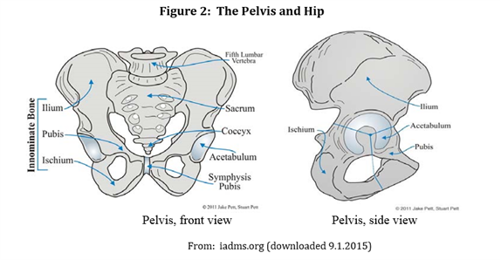The Pelvis: The Meeting Point of the Body
Author: Clara Fischer Gam on behalf of the IADMS Education Committee
We will get the week started with a post from the IADMS Education Committee. This is part 1 of a two-post discussion on pelvic structure and alignment. Today we will take a closer look at anatomy of the pelvis and share ideas for embodying these concepts in the studio.

Source: Getty Images
The pelvis as the “meeting point” of the body is a really clear analogy, as it is this structure that offers attachment for the legs and supports the spine and upper limbs. It plays a key part in bearing and transferring weight, it allows us to travel with dynamism as well as find balance and stability in the body. Experiential anatomy allows us to really develop a sound working knowledge of the anatomical structure; linking theoretical knowledge and practical exercises in class can be really useful for developing movement strategies, enhancing quality and intention for dance technique.
So, how is the pelvis structured?
The pelvis is made up of two halves, the innominate bones (or simply, hip bones). Each one is formed from the fusion of three bones: ilium, pubis and ischium. Together, these three bones contribute to the hip socket that connects the pelvis to the femur (more about the hip joint in a previous post).

Anteriorly, the hip bones are connected by the symphysis pubis, a cartilaginous joint. Posteriorly, they connect to the sacrum through the sacroiliac joint. The upper part of the sacrum connects with the 5th vertebra of the lumbar spine (lumbosacral joint). For a more comprehensive anatomy of the pelvis, check out this great video.
To bring about a more embodied knowledge of pelvic bones, I often encourage students to make use of touch as we go through anatomy concepts. Bone palpation activities can be easily applied to class when exploring anatomy of the pelvis. The author Andrea Olsen offers us a good suggestion:
Starting at a supine position, knees bent: trace the bones of the pelvis with the finger tips.
Firstly at the iliac crest, find the anterior superior iliac spines (ASIS), those bony projections at the front part of each hip bone. Then walk the fingers forward until the pubic symphysis.
Roll on your side: starting again at the iliac crest, trace the ilium back to the sacrum, feel the sacroiliac joint. Continue down the back of the pelvis and locate the ischial tuberosities (the "sitz" bones).
Flex the hip, and trace from the ischium to the pubic bone between the legs. Roll to the other side and repeat. You can find more experiential anatomy exercises on Olsen’s book, referred below.
Mainly, the pelvis moves as a whole: articulation occurs at the lumbosacral joint and at the heads of the femurs. It tilts anteriorly (allowing the tail bone to flare backward) posteriorly (tucking the tail bone under), laterally (lifting one side of the waist) and it also rotates (turn) for both sides. When watching students dancing, we may notice that ease of movement as well as restrictions for specific directions vary from dancer to dancer.
At a natural position in relation to the rest of the body, the pelvis is in the so-called neutral position: known for being the most stable and shock-absorbing for our structure, as surrounding joints and muscles are balanced. Watch out for our next post, where we will discuss the importance of pelvic alignment for optimal performance!
Something I really like to do to explore pelvic articulation and positioning is to practice the pelvic clock exercise as a warm-up in class (typical routine of Feldenkrais and Pilates sessions). That way, dancers can experiment with pelvic movements, discovering their own range of motion, restrictions and ultimately find their neutral pelvis. Watch a tutorial here.
Clara Fischer Gam, MS.
Dance Science Dance Education
Pilates Method
Rio de Janeiro – Brazil
Email: clara.figa@gmail.com
Keep Exploring:
Olsen, A. Bodystories: A Guide to Experiential Anatomy. Lebanon: University Press of New England, 1991.
Calais-Germain, B. Anatomy of Movement. Seatle: Eastland Press, 2007.
Fitt, S. Dance Kinesiology. New York: Schirmer Books, Second Edition, 1996.
Salk, J. Teaching modern technique through experiential anatomy. Journal of Dance Education. 2005;3(3): 97-102.
Batson, G. Somatic studies and dance. International Association for Dance Medicine and Science, 2009. Available here.